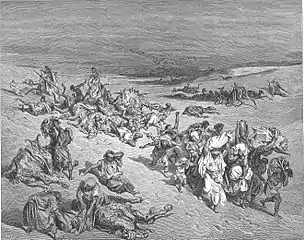Murrain /ˈmʌrɪn/[1] (also known as distemper) is an antiquated term for various infectious diseases affecting cattle and sheep.[2] The word originates from Middle English moreine or moryne, as a derivative of Latin mori "to die".[3]
The word murrain, much like the word pestilence, did not refer to a specific disease but rather served as an umbrella term for what are now recognized as a number of different diseases with high morbidity and mortality, such as rinderpest, erysipelas, foot-and-mouth disease, anthrax, and streptococcus infections. Some of these livestock diseases could also affect humans. The term murrain also referred to an epidemic of such a disease. There were major sheep- and cattle-murrains in Europe during the 14th century, which, combined with the Little Ice Age, resulted in the Great Famine of 1315–1317, weakening the population of Europe before the onset of the Black Death in 1348.[4]
Biblical references
The term murrain is also used in some Bible translations relating to the fifth plague brought upon Egypt. [5]
Exodus 9:3: "Behold, the hand of the LORD is upon thy cattle which is in the field, upon the horses, upon the asses, upon the camels, upon the oxen, and upon the sheep: there shall be a very grievous murrain."

"Pestilence", which is mentioned 47 times in 46 verses of the Bible, can be translated "murrain" by Christian apologists. [Enhanced Strong's Lexicon]. see Psalms 91:3 KJV
The word in Hebrew is דֶּבֶר "dever" (Strong's # 01698), derived from the primitive root "dabar" in the sense of "to destroy."
Superstitions
In some parts of Scotland, force-fire was believed to cure it. In some remote regions of Cumbria, England, and the Isle of Man, murrain is still used as a term for a curse, specifically one placed upon land or livestock. It is believed that the medieval term has, by a process of syncreticism become synonymous with witchcraft.[6] This usage inspired the ATV television play, Murrain, written by Manxman Nigel Kneale, which was broadcast on 27 July 1975 as part of the channel's Against the Crowd drama strand.
Distemper among cattle in England, 1745–1757
In those years, acts of the Parliament of Great Britain were passed to "more effectually to prevent the spreading of distemper which now rages amongst the horned cattle in this kingdom".[7]
For at least a dozen years, 1745-1757, a murrain made such tragic inroads upon the cattle of England that the virtual extinction of entire herds was frequently recorded. Within the period of greatest mortality, at least half a million cattle perished from the disease or were killed by official orders.[8]
— The Cattle Distemper in Mid-Eighteenth-Century England, Charles F Mullett, Department of History, University of Missouri
References
- ↑ "murrain". Collins English Dictionary (13th ed.). HarperCollins. 2018. ISBN 978-0-008-28437-4.
- ↑ Scott, Gordon. "The Murrain Now Known As Rinderpest". taa.org.uk. Archived from the original on 28 August 2008. Retrieved 28 July 2008.
- ↑ "murrain - Dictionary.com". dictionary.com. Retrieved 15 October 2008.
- ↑ Jordan, William C (1996). The Great Famine: Northern Europe in the Early Fourteenth Century. Princeton University Press. ISBN 0-691-05891-1.
- ↑ "Murrain (WebBible Encyclopedia) - ChristianAnswers.Net". christiananswers.net. Retrieved 28 July 2008.
- ↑ Billingsley, John. "Northern Earth - Medical Care, Magical Cure". northernearth.co.uk. Archived from the original on 25 September 2006. Retrieved 28 July 2008.
- ↑ For example, Pickering, Danby, ed. (1765). "Cap. XXXI". The Statutes at Large: from the 23rd to the 26th Year of King George II. Vol. 20. Cambridge: Charles Bathurst. p. 371. Retrieved 28 January 2020.
- ↑ Mullett, Charles F. (1946). "The Cattle Distemper in Mid-Eighteenth-Century England". Agricultural History. 20 (3): 144–165. JSTOR 3739806. Retrieved 8 December 2020.